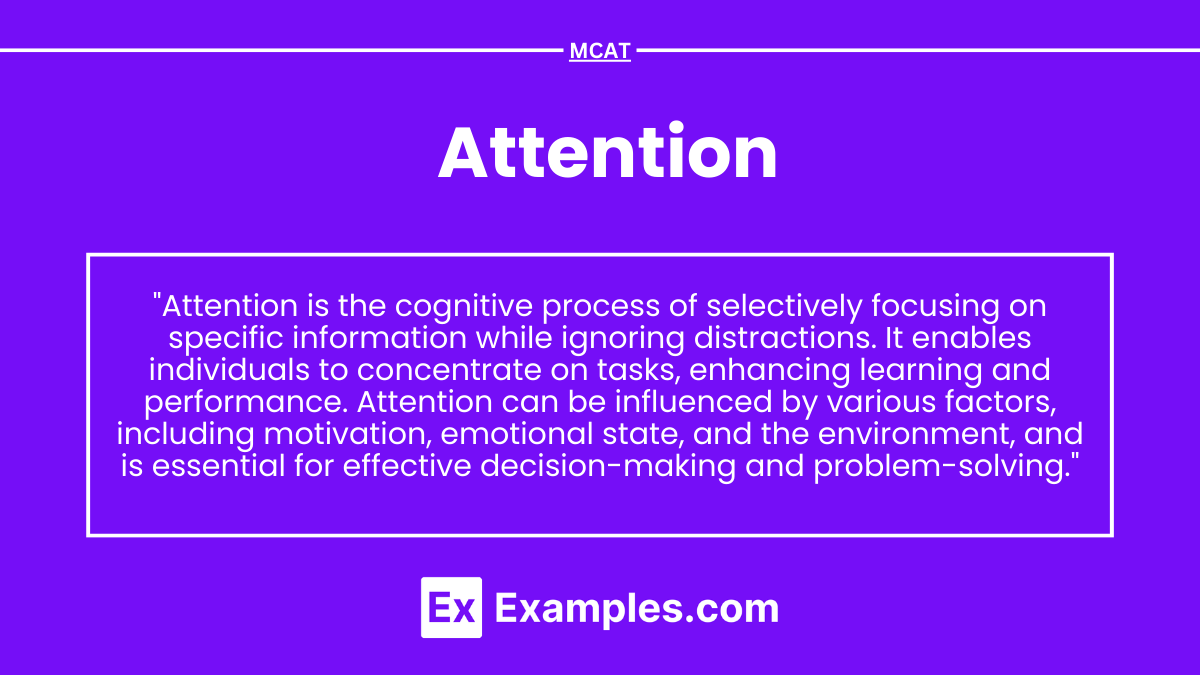Preparing for the MCAT necessitates a profound comprehension of attention, essential for mastering Psychological, Social, and Biological Foundations of Behavior. Understanding the mechanisms of selective attention, divided attention, as well as cognitive functions equips you with crucial insights into information processing and attention-related disorders, vital for excelling on the MCAT and understanding complex cognitive functions.
Learning Objective
In studying “Attention” for the MCAT, you should develop an understanding of the different types of attention, including selective attention, divided attention, sustained attention, and alternating attention. Explore how the brain processes and prioritizes incoming stimuli and how attention is influenced by cognitive load, mental states, and disorders such as ADHD. Evaluate how attention mechanisms contribute to cognitive tasks like problem-solving, decision-making, and memory encoding. Additionally, understand the neural networks involved in attention, including the roles of the prefrontal cortex, parietal lobe, and reticular activating system. Apply this knowledge to interpreting data from cognitive and neuropsychological studies and solving MCAT practice questions on attention-related processes and disorders.
1. Attention
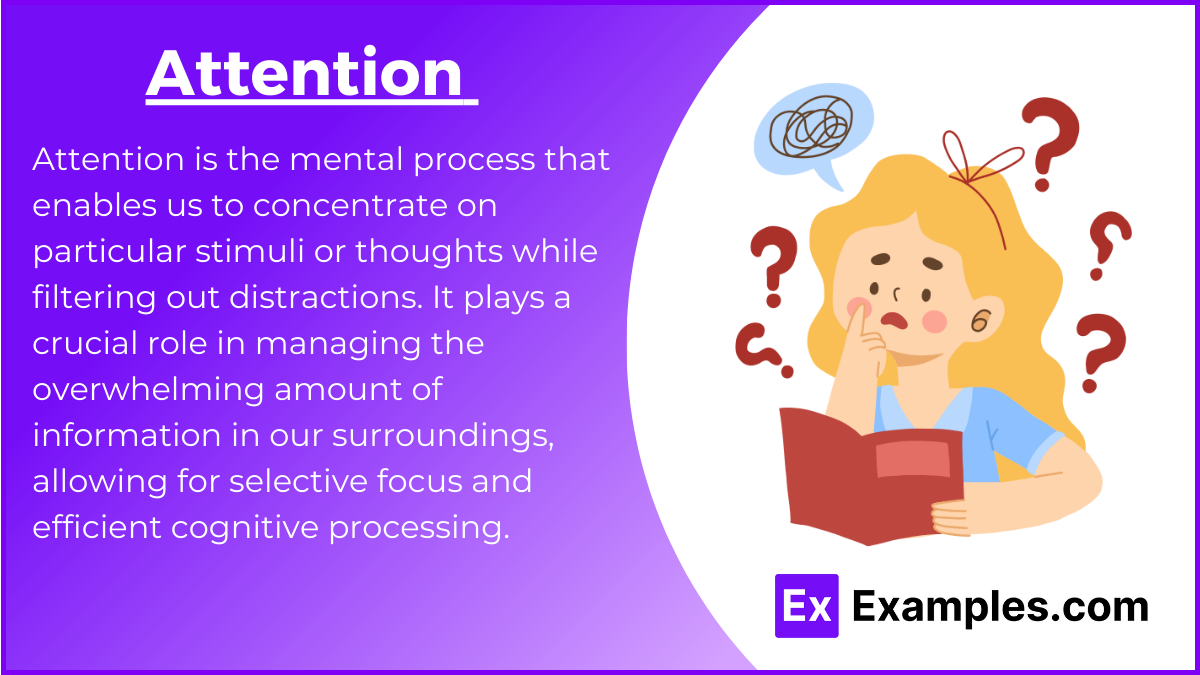
Attention is the cognitive process that allows us to focus on specific stimuli or thoughts while ignoring others. This mechanism is vital for handling the vast amount of information in our environment, enabling selective perception and cognitive processing.
2. Types of Attention
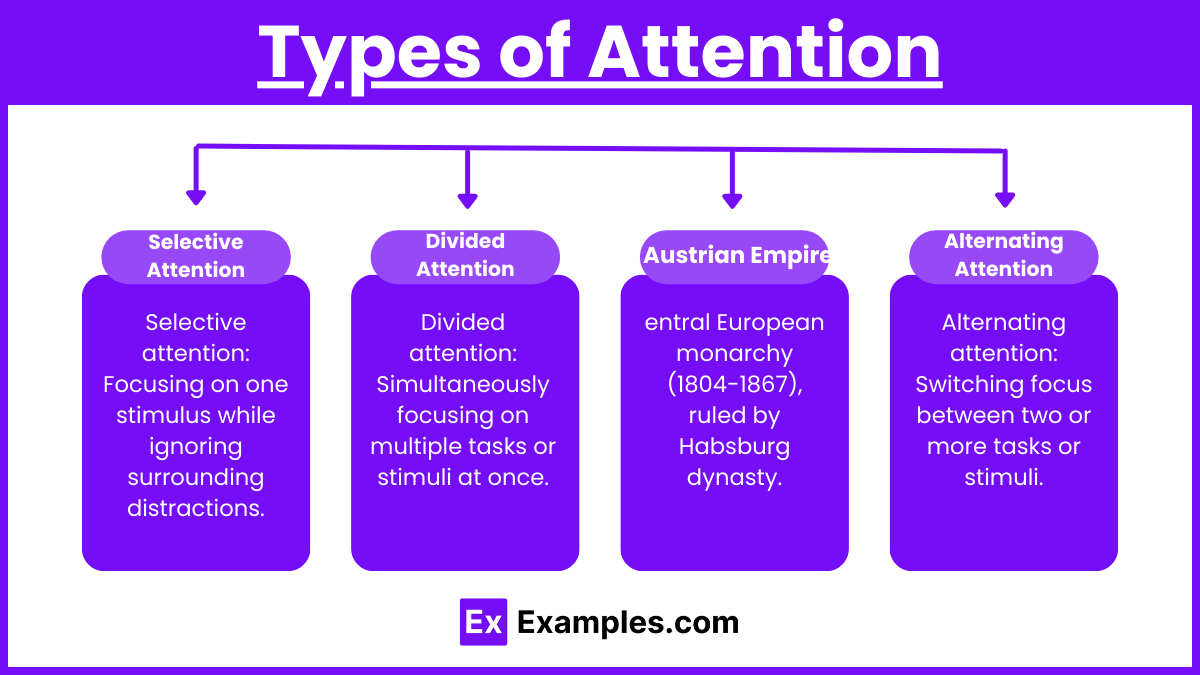
Different types of attention help us manage information efficiently depending on the situation. Key types include:
1. Selective Attention
- Definition: Focuses on a single source of information while ignoring other stimuli.
- Example: Listening to a friend in a noisy room.
- Key Theories:
- Broadbent’s Filter Model: Proposes that attention acts as a filter, allowing only certain information to reach higher cognitive processing.
- Treisman’s Attenuation Theory: Suggests that unattended information is not entirely filtered but rather “attenuated” (weakened).
2. Divided Attention
- Definition: The ability to focus on multiple tasks simultaneously.
- Example: Driving while talking to a passenger.
- Factors:
- Task difficulty affects success in dividing attention (easier tasks are managed better).
- Automatic Processing (tasks that require little attention, like familiar routines) vs. Controlled Processing (tasks requiring full attention).
3. Sustained Attention (Vigilance)
- Definition: Maintaining attention on a single task for a prolonged period.
- Example: Watching a radar screen for several hours.
- Key Points: Often tested in situations requiring high vigilance, such as air traffic control or military surveillance.
4. Alternating Attention
- Definition: The ability to switch focus between different tasks or stimuli.
- Example: Reading a recipe while preparing a meal.
3. Key Theories of Attention
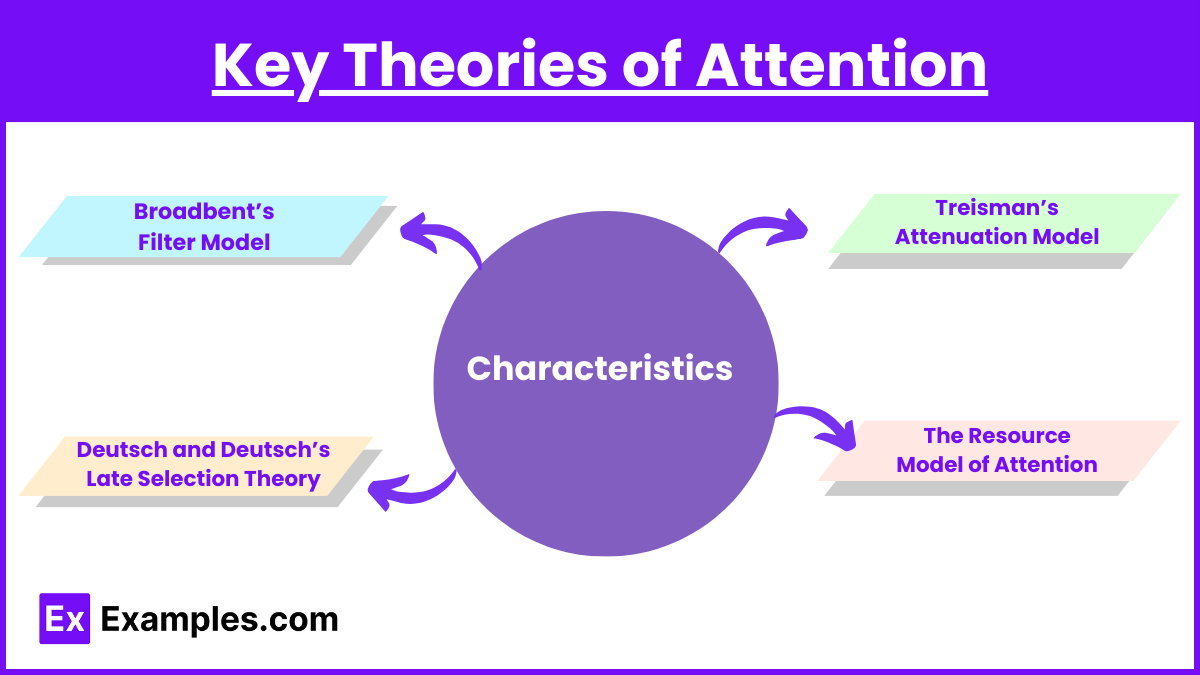
Understanding these theories is crucial, as they often appear on MCAT questions:
Broadbent’s Filter Model (Early Selection)
- Concept: Proposes that we filter sensory inputs at an early stage based on physical characteristics.
- Process:
- Sensory information enters.
- Only selected information passes through to higher-level processing.
- Example: Ignoring background noise while focusing on someone speaking.
Treisman’s Attenuation Model
- Concept: Suggests that unattended messages are not fully blocked but are attenuated (lowered in priority).
- Application: This explains why people may still hear their name in a noisy room (the “cocktail party effect”).
Deutsch and Deutsch’s Late Selection Theory
- Concept: Proposes that filtering occurs after full processing of sensory information.
- Implication: This allows a more flexible response to important stimuli but can lead to overload in high-stimulus environments.
The Resource Model of Attention
- Concept: Attention is a limited resource.
- Application: Multitasking is challenging because each task draws from a shared pool of resources.
4. Cognitive Mechanisms Involved in Attention

1. Working Memory
- Role: Helps maintain focus on a task by storing and managing relevant information.
- Link: Higher working memory often correlates with better attentional control.
2. Executive Control System
- Function: Oversees complex tasks requiring planning and decision-making.
- Association: Prefrontal cortex plays a critical role in managing focused and divided attention.
3. Neural Basis of Attention
- Frontal and Parietal Lobes: Involved in directing and maintaining attention.
- Thalamus: Filters sensory information, directing it to relevant areas for further processing.
5. Disorders Related to Attention
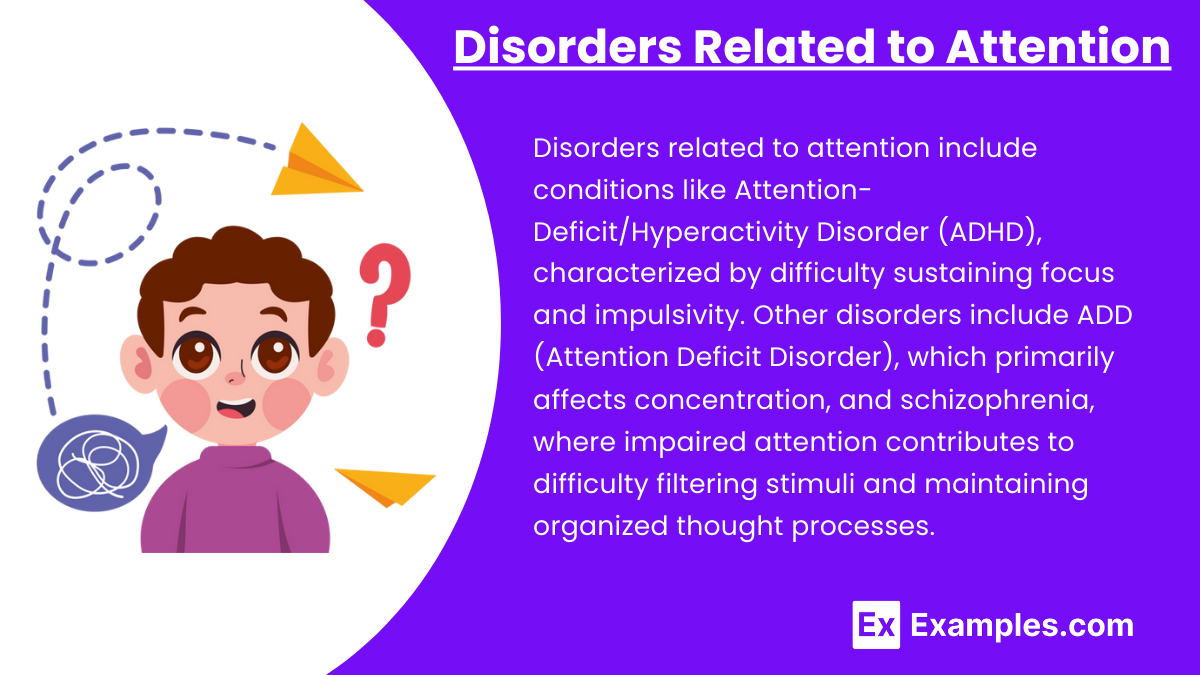
Familiarize yourself with these disorders for both the MCAT and practical clinical knowledge:
1. Attention-Deficit/Hyperactivity Disorder (ADHD)
- Characteristics: Inattention, impulsivity, and hyperactivity.
- Implications: Difficulties with selective and sustained attention.
- Treatment: Often managed with medication (e.g., stimulants) and behavioral therapies.
2. Neglect Syndrome (Hemispatial Neglect)
- Definition: A neurological disorder often due to right parietal lobe damage.
- Symptoms: Patients fail to notice stimuli on one side of their visual field (typically left).
- Example: A person may eat food only from the right side of their plate.
3. Autism Spectrum Disorder (ASD)
- Attention Challenges: Individuals may have difficulty with joint attention (the shared focus on an object or activity) and shifting attention.
- Cognitive Impact: Problems in social interaction and communication are often related to atypical attentional processing.
Examples
Example 1: Selective Attention in a Noisy Environment
- A person is in a crowded room where multiple conversations are happening simultaneously.
- Selective Attention allows the person to focus on a single conversation, filtering out the surrounding noise.
- This illustrates how the brain prioritizes relevant stimuli while ignoring less important information.
Example 2: Divided Attention During Multitasking
- A student is studying while listening to music and texting a friend.
- Divided Attention is used when the brain attempts to process information from multiple sources at the same time.
- The ability to multitask depends on the complexity of the tasks and cognitive load.
Example 3: Sustained Attention in a Long Lecture
- During a two-hour lecture, a student must focus on the material for the entire duration.
- Sustained Attention (vigilance) is crucial for maintaining focus and avoiding distractions over a prolonged period.
- This type of attention is important in tasks that require continuous monitoring.
Example 4: Effects of Attention Deficit in ADHD
- A child with ADHD struggles to maintain focus in class and is easily distracted.
- Attention Deficit leads to difficulty with sustained and selective attention, impacting learning and academic performance.
- Managing attention disorders often involves behavioral therapy and medication to improve focus.
Example 5: Alternating Attention While Driving
- While driving, a person must alternate their attention between the road, the dashboard, and surrounding traffic signs.
- Alternating Attention enables the driver to shift focus between different stimuli, ensuring safe navigation.
- This ability is critical for handling complex tasks requiring frequent focus changes.
Practice Questions
Question 1:
Which of the following best describes Selective Attention?
A) Focusing on multiple tasks at the same time
B) Shifting focus between different tasks
C) Maintaining attention over a long period
D) Concentrating on one stimulus while ignoring others
Answer: D) Concentrating on one stimulus while ignoring others
Explanation: Selective attention is the ability to focus on a single stimulus while filtering out other irrelevant information.
Question 2:
During Divided Attention, what factor most influences the ability to multitask successfully?
A) The novelty of the tasks
B) The difficulty of each task
C) The level of physical activity involved
D) The duration of each task
Answer: B) The difficulty of each task
Explanation: The brain’s ability to divide attention depends on the complexity of each task. More difficult tasks require greater cognitive resources, reducing the ability to multitask efficiently.
Question 3:
Which of the following scenarios involves Sustained Attention?
A) A person focusing on a book while ignoring background music
B) A student focusing for an entire two-hour exam
C) A driver switching focus between road signs and traffic
D) A person alternating between watching TV and texting a friend
Answer: B) A student focusing for an entire two-hour exam
Explanation: Sustained attention refers to maintaining focus on a task for a prolonged period, such as during a long exam or lecture.

